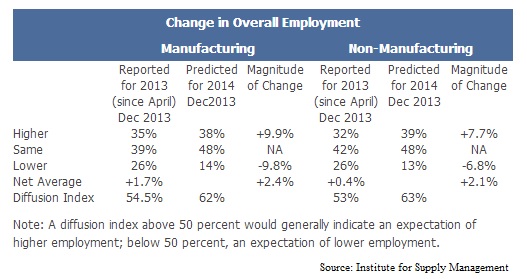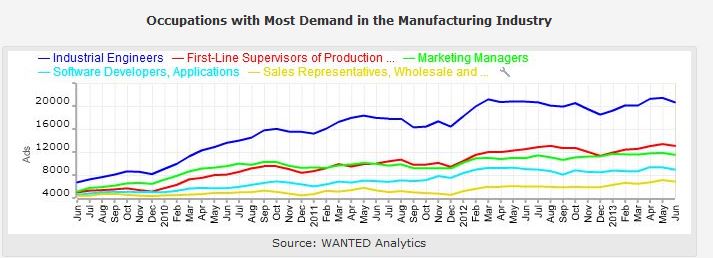Already enjoying a strong year of sales and increased attention from the investment community, manufacturers are predicting they’ll add staff next year at a rate faster the service sector.
Instead of cutting production workers and outsourcing overseas, manufacturers are bringing more work back onshore, necessitating the hiring of workers. The Institute for Supply Management survey of its manufacturing members found they expect to increase staffing by an average of 2.4 percent next year. Revenues are projected to rise by an average of 4.6 percent.
The survey found 44 percent of manufacturing ISM members see better conditions ahead. The Federal Reserve’s most recent Beige Book report echoes that finding. “Manufacturers in many Districts expressed optimism about near-term growth prospects,” the Fed says in the report on current economic conditions.
Demand for high-skill labor is growing
“Manufacturing purchasing and supply executives expect to see continued growth in 2014. They are optimistic about their overall business prospects for the first half of 2014, and are even more optimistic about the second half of 2014,” said Bradley J. Holcomb, chair of the ISM Manufacturing Business Survey Committee.
The purchasing and supply professionals who make up the membership of the Institute for Supply Management (ISM) see sales growth and government issues as the biggest challenges manufacturers face; operations managers and CEOs worry about finding the skilled workers needed to fill the jobs they’re creating.
“Whether it’s due to more conservative hiring practices, changing demographics or negative perceptions of manufacturing jobs, the demand for high-skill labor is growing faster than supply,” writes Pradeep Amladi, vice president, Discrete Manufacturing Industries, SAP.
A few years ago, Nuts, Bolts and Thingamajigs, the Foundation of the Fabricators & Manufacturers Association, Intl. surveyed teenagers about their perception of manufacturing and potential interest in a manufacturing career. What the foundation discovered to no one’s surprise is that 52 percent of the teens had little interest in manufacturing and 21 percent were ambivalent.
Why? Some 61 percent said it was because they wanted to pursue a white-collar career.
A white paper issued by the trade group flatly declared, “Manufacturers simply cannot find the skilled labor needed today to handle the kinds of sophisticated production processes and tasks required on the manufacturing shop floor.”
An ongoing worker shortage
Even in other areas, manufacturers worry about their ability to hire. An Accenture report found 55 percent of manufacturers says they have or will have a shortage of people with the right skills in research and development. Half the surveyed manufacturers say they are facing a similar shortage in marketing.
Hiring in the manufacturing sector has been rising steadily. Wanted Analytics noted in July that the online job postings for jobs in manufacturing companies rose to a four-year high in May. It dipped slightly the following month, when the firm’s analysis of online listings found 259,000 jobs.
 Industrial engineers are the most in-demand occupation in the manufacturing sector,” Wanted said on its blog. “First-line supervisors of production workers, marketing managers, applications software developers, and sales representatives (wholesale and manufacturing) filled out the top five manufacturing occupations.”‘
Industrial engineers are the most in-demand occupation in the manufacturing sector,” Wanted said on its blog. “First-line supervisors of production workers, marketing managers, applications software developers, and sales representatives (wholesale and manufacturing) filled out the top five manufacturing occupations.”‘
From November 2012 to November 2013 manufacturers added 76,000 new jobs, not a big number, but more than the information sector and just 7,000 jobs fewer than in the financial sector and a third that of the fast-growing temp sector.
This month, the LINE prediction from the Society for Human Resource Management says manufacturer hiring will accelerate compared to December of last year, while the normally expanding services sector will see a decline in its hiring rate.
According to SHRM: “A net of 31.6 percent of manufacturers will add jobs in December (40.9 percent will hire, 9.3 percent will cut jobs). The sector’s hiring index will increase by 6.3 points compared with a year ago.”
